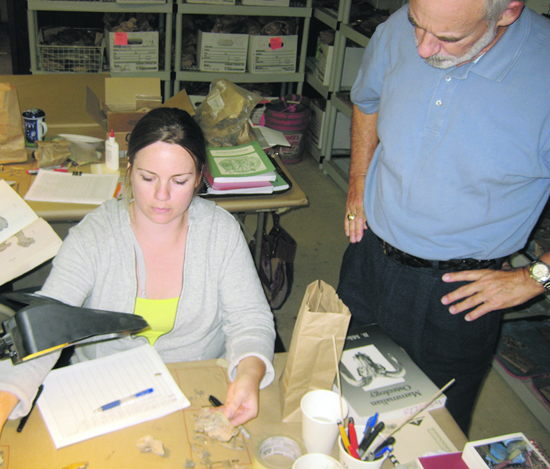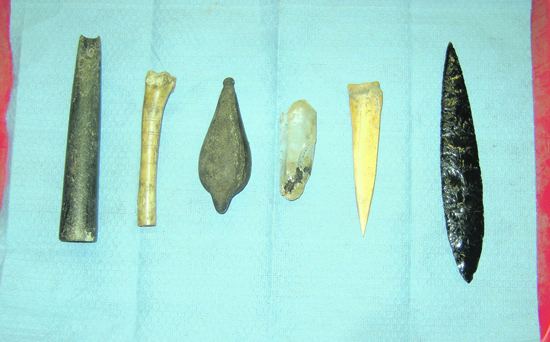 | | | Jim Allan discusses findings with WSA scientists in the lab.
Photos Sophie Braccini
| | | | | |
Beware: scientists at work, high brain energy in the air - yet all is quiet in the offices of WSA, both in the Orinda office and the lab in Walnut Creek. WSA is an Orinda-based cultural resources management consulting firm where archeologists operate on the fine line between 'for profit' and academic work.
 Headed by Jim Allan in Orinda, who also teaches at Saint Mary's College, and William Self in Arizona, the firm is called upon to investigate sites that are going to be disturbed, mostly by construction. Per regulations, all that work has to be paid by the project's developer. "We used to hear a lot of complaints about these costs," says Allan, "but now people are used to it and they know it is part of the game." This work can also lead to significant discoveries.
Headed by Jim Allan in Orinda, who also teaches at Saint Mary's College, and William Self in Arizona, the firm is called upon to investigate sites that are going to be disturbed, mostly by construction. Per regulations, all that work has to be paid by the project's developer. "We used to hear a lot of complaints about these costs," says Allan, "but now people are used to it and they know it is part of the game." This work can also lead to significant discoveries.
 When a site contains elements of historical significance, archeologists must identify the findings, and depending on their importance, document, record, and/or preserve what was in the soil. If the findings are significant enough, a project may be modified or the findings archived in a State or National repository; sometimes resulting a published scientific article.
When a site contains elements of historical significance, archeologists must identify the findings, and depending on their importance, document, record, and/or preserve what was in the soil. If the findings are significant enough, a project may be modified or the findings archived in a State or National repository; sometimes resulting a published scientific article.
 WSA was founded by archeologist William Self when he lived in Orinda. The archeologist took Allan as a partner and went to open a new branch of the company in Tucson, Arizona. Allan leads the California operation and a team of 22 scientists with advanced degrees, nearly half of whom hold a Ph.D.
WSA was founded by archeologist William Self when he lived in Orinda. The archeologist took Allan as a partner and went to open a new branch of the company in Tucson, Arizona. Allan leads the California operation and a team of 22 scientists with advanced degrees, nearly half of whom hold a Ph.D.
 He is also a specialist in sub-marine archeology (he takes a group of students to Bermuda every summer to research shipwrecks) and teaches at Saint Mary's College. "Having both occupations is a ton of fun," says Allan, "With the consulting work we are 'doing' archeology - it is profit oriented and has to be on time and on budget. Working with students is very energizing. The students push me and I can pursue scholarly interests with much less of a timeline."
He is also a specialist in sub-marine archeology (he takes a group of students to Bermuda every summer to research shipwrecks) and teaches at Saint Mary's College. "Having both occupations is a ton of fun," says Allan, "With the consulting work we are 'doing' archeology - it is profit oriented and has to be on time and on budget. Working with students is very energizing. The students push me and I can pursue scholarly interests with much less of a timeline."
 Locally WSA is finishing the preservation work around the construction of a shopping center in Pleasant Hill. "We knew from previous work that the site was a Native American settlement and burial site," said Allan, "we were not expecting to find so many remains when we submitted our proposal."
Locally WSA is finishing the preservation work around the construction of a shopping center in Pleasant Hill. "We knew from previous work that the site was a Native American settlement and burial site," said Allan, "we were not expecting to find so many remains when we submitted our proposal."
 Just digging the trenches for utilities and other necessities in the parking lot uncovered 120 burial sites. "What the tribal descendants wanted was that all the human remains that were excavated because of the construction be placed in a vault and buried back on the premises after proper ceremonies are performed." Allan declined to indicate the exact location of the remains because it was the desire of the Native Americans not to identify it in any way.
Just digging the trenches for utilities and other necessities in the parking lot uncovered 120 burial sites. "What the tribal descendants wanted was that all the human remains that were excavated because of the construction be placed in a vault and buried back on the premises after proper ceremonies are performed." Allan declined to indicate the exact location of the remains because it was the desire of the Native Americans not to identify it in any way.
 A lot of the research work took place in WSA's lab. Scientists studied the bones and drew conclusions on the type of life the indigenous people lived. "We've found two layers of settlements," explains Rhea Sanchez, who particularly works on animal bones, "One that dates back 400 to 500 years and another one that's more than a thousand years old."
A lot of the research work took place in WSA's lab. Scientists studied the bones and drew conclusions on the type of life the indigenous people lived. "We've found two layers of settlements," explains Rhea Sanchez, who particularly works on animal bones, "One that dates back 400 to 500 years and another one that's more than a thousand years old."
 From their findings, the archeologists draw conclusions on the way of life of the native tribes, their migration patterns, what they ate, their religious and symbolic life. In the lab, the young scientists are still studying bones bearing symbolic carvings and pear-shaped carved stones that took hours to shape, hypothesizing on their functions.
From their findings, the archeologists draw conclusions on the way of life of the native tribes, their migration patterns, what they ate, their religious and symbolic life. In the lab, the young scientists are still studying bones bearing symbolic carvings and pear-shaped carved stones that took hours to shape, hypothesizing on their functions.
 WSA has been involved in several significant projects in the Bay Area, including the Carquinez Bridge and the Bay Front Shopping Center. Closer to home, the consulting firm was asked its opinion of the J&J Ranch development project that comprises the historical Joaquin Moraga Adobe, constructed in approximately 1841, which is the oldest remaining adobe residence in Contra Costa County. WSA has been involved in several significant projects in the Bay Area, including the Carquinez Bridge and the Bay Front Shopping Center. Closer to home, the consulting firm was asked its opinion of the J&J Ranch development project that comprises the historical Joaquin Moraga Adobe, constructed in approximately 1841, which is the oldest remaining adobe residence in Contra Costa County.
 WSA evaluated archeological and paleontological resources on the site and identified potential project-related impacts, and completed a stand-alone Cultural Resources Assessment Report. The report, ordered by the City of Orinda, was conducted in collaboration with Architectural Resources Group that studied the historical and cultural resource assessment of the project. WSA concluded that the Moraga Adobe site, based on preliminary archeological site reconnaissance, appears eligible for listing as a historical resource. The consultants made several recommendations in the design of the project to limit its impact on the site (final decisions have not been made on this project).
WSA evaluated archeological and paleontological resources on the site and identified potential project-related impacts, and completed a stand-alone Cultural Resources Assessment Report. The report, ordered by the City of Orinda, was conducted in collaboration with Architectural Resources Group that studied the historical and cultural resource assessment of the project. WSA concluded that the Moraga Adobe site, based on preliminary archeological site reconnaissance, appears eligible for listing as a historical resource. The consultants made several recommendations in the design of the project to limit its impact on the site (final decisions have not been made on this project).

|

